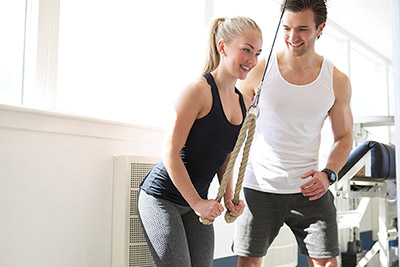Bench: A bench refers to the platform you sit or recline on when training. It’s also an action term (“to bench”) that refers to the bench press exercise. See “press.”
Cable: Among the strength training machines in the gym, cable machines are stations that feature pulley systems with handles instead of straight bars and levers.
Circuit: Circuit training involves a group of assorted strength exercises performed one exercise after another, often for a specified time period before moving on to the next. When all the exercises are complete, that is a circuit, which may be repeated.
Compound: Compound exercises are movements that require more than one joint. For instance, in a squat, your ankle, knee and hips joints are involved in the exercise.
Concentric: The concentric phase of an exercise is lifting or push phase—the effort.
Curl: When you pull the weight in toward your body, it’s a curl. For instance, biceps curl bends at the elbow to pull the weight toward the chest.
Decline: When the angle of a bench, platform, or your body is reaching downward from flat/parallel to the floor. For instance, when doing a decline pushup, your hands are lower than your feet.
Definition: Definition refers to the ability to see the outlines of your muscles under the surface of your skin.
Eccentric: The eccentric phase of an exercise is the lowering or negative phase—the return.
(To) Failure: When you cannot physically perform any more reps with proper technique, you’ve taken the exercise to failure. See “reps.”
Free Weights: Unlike weights attached to a machine, free weights are unattached and come in the form of dumbbells and barbells with weight plates (the weights you put on the end of the bar).
Incline: When the angle of a bench, platform, or your body is reaching upward, away from flat/parallel to the floor. For instance, when sitting back on an incline bench, your head is higher than your chest.
Isolation: Isolation exercises are movements that require only one joint to perform the exercise. For example, a biceps curl (see “curl”) involves only the elbow joint.
Mass: Muscle mass refers to the relative size of and weight of muscle.
One rep max or 1RM: See “reps.” When you can only do one rep of a certain exercise using a certain weight, that is your one rep max—it’s the heaviest weight you can lift, once.
Press: A movement that pushes the weight away from the body, against resistance. Example of press exercises are bench press which pushes the weight away from the chest, a seated leg press which pushes the weight away from the hips and torso, or an overhead press which pushes the weight up above the head.
Reps: Repetitions. Reps are the number of times an exercise is repeated within a single exercise set…. See “set.”
Resistance training: See “strength training”
Rest between sets: The amount of time you stop working in between each set of an exercise. It might be a short rest, like 20 seconds, or a few minutes for powerlifting.
Set: This is the basic unit or group of repetitions (see “reps”) you will perform of a single exercise. For example, you might do 1 set of 10 reps or 3 sets of 12 reps.
Spotter: A spotter watches you as you are performing a challenging exercise, and is there to help you lift the weight back into starting position if you have trouble. See “to failure.”
Strength training/weight training: Exercise against resistance (usually weights) that gets progressively heavier as you get stronger is also called strength training, weight training or even weight lifting.
This content was originally published here.









